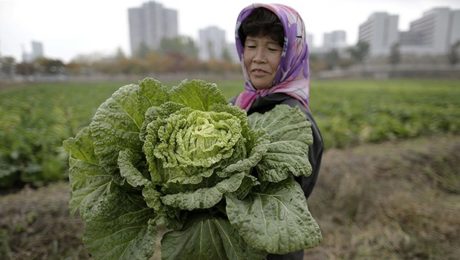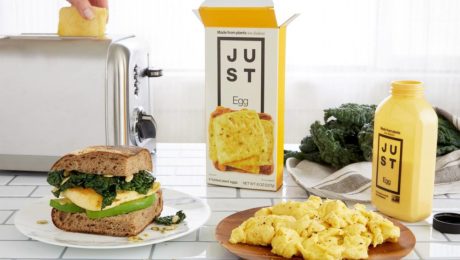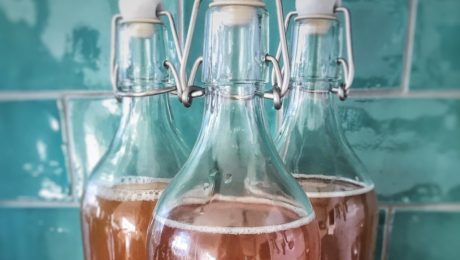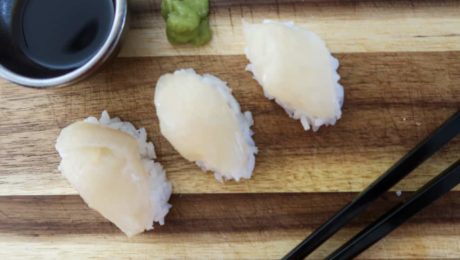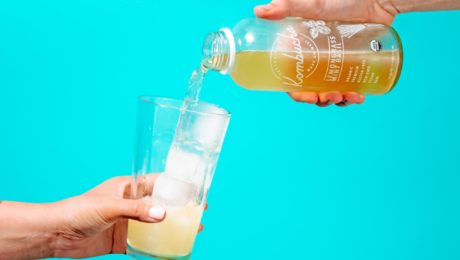Cabbage Shortage Forces Halt in Winter Kimchi
A cabbage shortage is forcing North Koreans to give up winter kimchi making for the second year in a row. They are unable to take part in gimjang, the Korean tradition of communally preparing kimchi each October for the winter season.
Flood damage and poor crop yields led to a poor cabbage (and radish) growing season. The cabbage that was harvested was mostly routed to military and government agencies, “leaving the people empty handed.” Cabbage prices have risen 25% from a year ago, “making a large batch of kimchi cost more than a government-provided monthly salary,” according to Radio Free Asia.
Read more (Radio Free Asia)
- Published in Business, Food & Flavor
Natural & Health Labels Can be Regulatory Nightmare
Brands need to be extra vigilant over the health claims they put on their labels. A simple phrase like “Supports immunity,” “Aids respiratory health” or “Full of natural flavors” could result in a lawsuit from the Food and Drug Administration (FDA), Federal Trade Commission (FTC) or a state attorney general.
“The FDA is able to set very broad and very narrow regulations in terms of what our labels can look like, what can be included in the products, what kind of claims we can make for the products, who the products can be distributed too, how they can be imported and exported and the like,” says Claudia Lewis, partner at Venable LLP, a Washington D.C.-based law firm.
Complying with these sometimes archaic laws can be challenging. The FDA, which ensures food safety, has a large jurisdictional footprint, regulating about 30 cents of every dollar Americans spend. The FTC is the authority on advertising and marketing claims for food, beverage and supplement products, and it may challenge a food brand if its marketing is deemed false, deceptive and/or misleading.
“Typically, if you’re in an FTC investigation, you’re going to have at least $300,000 in legal fees by the time you’re finished, if not over half a million dollars,” says Todd Harrison, partner at Venable. “The FTC is a very expensive regulatory agency to deal with. They can make your life pretty miserable.”
Harrison and Lewis specialize in representing functional food brands at their law firm and spoke at Expo East on the topic of Legal and Regulatory State of the Natural Products Industry. [The Fermentation Association’s virtual conference, FERMENTATION 2021 will also cover this and related topics — please check our Agenda for the latest sessions and speakers.]
Harrison and Lewis reviewed two main areas where improper labeling can get a food brand into trouble with regulators.
Using Covid-19 as a Marketing Tool
Shortly after the Covid-19 pandemic started, the FDA offered a unique relaxation of their rules and regulations for food products. Brands were challenged with supply chain disruptions and ingredient shortages. The FDA allowed temporary ingredient and formulation changes without a label overhaul, as long as the new ingredient was non-allergenic, 2% or less of the weight of the finished product, not a main or characterizing ingredient and not affecting health claims.
Though the temporary rule allows for flexibility, Harrison advises it still leaves room for litigation. Plaintiff attorneys can still sue for changes in a product’s flavor.
“Minor changes are fine from an FDA perspective, but not necessarily good from a plaintiff perspective,” he adds.
Covid-19 has also spurred a gray area in food marketing claims. Labels claiming the product prevents, treats or mitigates Covid-19 are illegal and being “aggressively pursued.”
“Anytime you mention the word coronavirus or Covid, the FDA is not going to agree with what you say because everyone will think you’re somehow implying something,” Harrison says.
Context is critical, as the agency is cracking down on any brands making health claims implying their product could prevent Covid. Brands using the phrases “immunity support” or “immune boosting” on their labels — or even on their social media pages — could be targeted by the FDA.
“The FDA has historically not liked (brands to use the term) immunity, but it was always low risk (pre-pandemic), you’d likely get a warning letter,” Harrison says. “However, in the world we live in today, the word immunity is persona non grata to the agency. Especially if you add the word respiratory on it. If you put the words ‘immunity’ and ‘respiratory’ on a label, the agency is saying ‘It’s Covid.’”
Harrison also cautions against connecting science-backed supplements and vitamins to treating a Covid infection. He uses the example of vitamin D — plentiful scientific research proves vitamin D boosts immunity, but a food brand cannot legally make that association, and doing so can set it up for litigation. Though vitamin D “is a cheap way of helping reduce your risk of (Covid-19) severity, it’s not going to keep you from getting Covid,” Harrison explains. “The way the paradigm is set up, even if you have really good science in your favor, you can’t make the claim unless you have approval by the FDA.”
“Natural” and “Health Food” Still Debatable Terms
Because there is no FDA or FTC definition of “natural,” lawsuits against brands claiming their product is natural or similar claims are prevalent. (The FDA requested public comments on the term “natural” in 2016, but no rule was issued on the policy.)
And these lawsuits don’t always come from the federal agencies. Class action lawsuits are “still alive and well,” Lewis adds. A formal definition would help protect brands because plaintiffs are filling in the holes and filing costly lawsuits. She uses the example of Welch’s Fruit Snacks, which was sued for being “more candy than fruit.”
“The plaintiffs bar has seized on that and taken these companies to task,” she says. “This wording about ‘healthy’ and this wording of ‘natural’ is also taking on a different dynamic because of consumer perception. How consumers perceive these words and how consumers’ expectations are not keeping with FDA regulations, but the plaintiff bar is using that as an opening and getting pretty good settlements in connection with consumer perception.”
Making a health inference is a slippery slope. The FDA deems a healthy food as one that suggests the product can help maintain “healthy dietary practices.” Health foods are required to be low in fat, saturated fat, cholesterol and sodium.One or more qualifying nutrients must also make up at least 10% of their weight..
For example, IZZE, makers of sparkling juices, was sued for misleading marketing because, though the drink advertised “no sugar added,” it failed to disclose it was not low in calories — a requirement under FDA regulations. Harrison takes issue with the FDA defining healthy in these confusing terms.
“I’d say it’s unconstitutional and I think I’d win that case because healthy is now low fat, low saturated food and a certain amount of macronutrients. It’s a much more complex question than that. But yet this is what plaintiff attorneys seize on,” Harrison says.
Though a new food product may be utilizing health ingredients on the cutting edge of scientific research, Harrison warns the FDA is “notoriously behind nutrition science” and brands need to be careful. He says don’t trust the government agency to keep up.
“Nutrition has evolved and continues to evolve,” he says, noting the FDA regulation to put “low fat” as a nutrient content claim just stripped fat out of food (including beneficial fat) and replaced it with simple carbohydrates. Most members of Congress “don’t know a damn thing” about health food. “We know what’s good for us. We’re not stupid people.”
How Can Brands Educate Consumers on Alt Protein?
Alternative protein companies need to stop advertising their brand as the most ethical choice and instead appeal to consumer’s taste buds.
“Sometimes plant-based food companies don’t really market themselves as food,” says Thomas Rossmeissl, head of global marketing for Eat Just, Inc., which develops plant-based “eggs” and cell-cultivated meat. “There’s this inclination to talk about mission. We say ‘We’re good for the planet,’ ‘It’s good for you,’ ‘It’s good for animals’ and obviously that’s all true and it’s admirable and it’s what drives me in our company. But it can come off like we’re sort of apologizing, that we’re negotiating with consumers, that a consumer is sacrificing something delicious to get something ethical or healthy.”
“People not buying (traditional)meat and cheese because an animal was killed or tortured. They buy because it tastes great.”
Irina Gerry concurs. Gerry is the chief marketing officer for Change Foods, an animal-free dairy brand that will launch their product in 2023. Alternative protein brands need to “flip the script from plant-based, rationalizing the food choices.” Brands need to help consumers feel that purchasing an alternative protein is a “natural choice rather than a sacrifice.”
The two spoke on a panel Insights on Consumer Perceptions of Alternative Proteins at the virtual Good Food Conference. The conference is put on by the Good Food Institute, an international nonprofit that promotes plant- and cell-based meat.
Wide Consumer Base Wanting Animal-Free
Animal-free is the main driver for customers to buy alternative products. The alternative protein industry is not just marketing to vegans, they’re also selling to flexitarians and omnivores concerned about welfare. Ninety-four percent of Eat Just consumers consume some type of animal protein.
“Sustainability is skyrocketing and potentially could cross over health as the main motivator, especially in the younger population,” Gerry says.
The modern American household family fridge is divided. There may be three types of eggs in there — conventional, cage-free and plant-based — and three types of milk — dairy milk, almond and oat. Consumers as young as 12 are the ones educating themselves on alternative proteins.
“We’re going to see this younger generation drive families to plant-based solutions,” Rossmeissl says.
Staying Honest, Maintaining Trust
Transparency will be central to public adoption. Laura Reiley, a reporter for The Washington Post who moderated the panel, noted “there hasn’t been tremendous transparency” with the alt protein market. She’s written about the market since its beginning and notes, because there’s intellectual property and so much research and development dollars, most companies have kept their food shrouded in mystery.
“We don’t want to sort of follow the example of the conventional industry. We can do better than that,” Rossmeissl says. “On the cultivated side, we have a huge responsibility to get this right. Not just as a company but as an industry, we can’t screw this up.”
Perceived unnaturalness by consumers of alt protein is a challenge. Using the term lab-grown “is disparaging to us as an industry” he continues, “but I think the best way we can address that is by being really honest and what’s in it and how it’s made.”
Gerry notes 90% of dairy cheese sold globally is made with non-animal remnants through precision fermentation — and that’s been the predominant way traditional cheese is made for over 20 years. It’s the same technology Change Food’s animal-free cheese uses.
“(These traditional cheeses) made through precision fermentation, they’re labeled under natural and oftentimes organic cheese products and nobody’s grown a third leg and nobody’s freaked out, right?” Gerry continues. “But now we’ve added one more element of that cheese — removing the cow from the cheese — and everybody seems to be greatly concerned.”
The Forefront of Alt-Proteins in Africa
Price and regulation are big roadblocks for alternative proteins, an industry that is expanding rapidly, as more consumers turn to animal-free products out of concern for their health, the environment and animal welfare.
“People love meat but, at the end of the day, they’re not really attached to how it got to their plates,” says Brett Thompson, co-founder and CEO of Mzansi Meat, a cultivated meat company in South Africa. Thompson spoke at the TFA webinar The Forefront of Alt-Proteins in Africa with another leader in the South African alternative protein industry, Leah Bessa, PhD, co-founder and CSO of De Novo Dairy.
Alt-protein companies all over the world are bringing cultivated meat and dairy to consumers, but Africa as a continent has lagged.. Thompson founded Mzansi Meat Co. in 2020 and hopes to bring cell-cultured beef, chicken and braai sausages (traditional South African BBQ-style sausages) to retail shelves next year. De Novo Dairy, formed in 2021, is using precision fermentation to create milk proteins for animal-free dairy products, but without cows.
This novel biotechnology is new in South Africa, but it’s a critical element in addressing food security problems in Africa. Africans don’t consume enough food, especially protein, and as drought continues to plague the continent, raising animals for traditional meat products is becoming less and less sustainable.
“It’s a very different conversation to the rest of the world,” Thompson adds. “It’s about getting more protein into more people’s stomachs and plates.”
Big Production Costs in New Alt-Protein Space
Interest is high from investors, but scaling from pilot stage to large-scale production is challenging. Equipment is costly and labor is difficult to recruit to a new industry.
In a survey conducted by Mzansi, 50% of South Africans were willing to purchase alternative protein products — and they’d pay a higher price than for traditional meat.
“But we just got to make it available,” Thompson says. “That’s going to be the biggest hurdle for us, getting it into retail and getting it in front of people so that they can make that decision.”
Bessa says that, critical to the adoption of animal-free dairy, the consumer must receive “nature identical” products. These must replicate the taste, texture and nutrition level of traditional dairy — and precision fermentation is a “powerful tool” to helping achieve that goal.
“It’s going to be a very easy sell,” Bessa adds. “What’s really great about precision fermentation is, as a technology, it’s not limited to just one or two proteins. You can really explore other functional elements and other functional proteins across the food industry. So we’re really looking beyond just dairy, but we want to solve a big problem in the dairy industry because it’s very unsustainable.”
The Good, the Bad & the Ugly — of Government Regulation
Bessa notes regulation is a bigger challenge than technology for De Novo. Three governmental bodies in Africa oversee food production — the departments of trade, health and agriculture. Mzansi is exploring launching in food service, as an alternative to the long, arduous process of securing government approval to sell a product at retail.
“Consumers want something that’s familiar but, now with regulatory hurdles, if you have to classify and label them differently, then how familiar would that label be to consumers?” says Josephine Wee, assistant professor of food science at Penn State University (and a TFA Advisory Board member). Wee moderated the discussion with Thompson and Bessa. “I think it’s an important conversation as well because it might be confusing if it tastes just like milk but is labeled completely different.”
Transparency is a priority for both Mzansi and De Novo. Thompson says companies preaching sustainability can’t be “cagey…or you send out messages that are convoluted.” Bessa agrees, noting a young company may never recover from bad publicity over transparency issues.
“Working with new technologies, especially in food, which is such a personal thing for people, you almost want to get ahead of assumptions, you want to be the one putting out the information and the correct information,” Bessa says. “That’s why it’s so important because you’re working with a novel technology, you’re feeding people with this novel technology, and so it’s important to be transparent so that they feel comfortable and they can relate to what they’re consuming.”
- Published in Business, Food & Flavor
Ireland’s Fermented Drinks Under Scrutiny
After a study found 91% of plant-based, fermented drinks in Ireland make unauthorized health claims, the Food Safety Authority of Ireland (FSAI) has published a guide on how to produce such beverages safely and label them accurately.
The FSAI examined 32 unpasteurized drinks currently sold on the Irish market – including kombucha, kefir and ginger soda – and found that most did not comply with EU and Irish food labelling and health regulations. The study found 13% had alcohol levels above labelling thresholds, and 75% lacked required label information, like the address of the producer and “best-before” date.
“The methods used in producing unpasteurized fermented plant-based products can be difficult to manage,” notes Dr. Pamela Byrne, FSAI chief executive. “The guidance will help producers to achieve consistent production methods, safe storage, safe handling and safe transportation of fermented beverages.”
Read more (Agriland)
Alt Fish Protein Launch
A female-led food startup is the first in the world to develop a whole-muscle cut of alternative seafood “meat.” Aqua Cultured Foods, based in Chicago, uses biomass fermentation technology to produce alternative fish products, like filets of tuna and white fish, calamari and shrimp.
The company makes seafood analogs using a proprietary strain of fungi. Vegconomist describes their microbial fermentation process as “growing” protein rather than food processing of a plant-based product. Fermentation allows Aqua Cultured Foods to mimic the taste, texture and nutrients of fish.
“Biomass fermentation delivers a whole, unprocessed seafood alternative that is very different from plant-based seafoods available today. We can adjust the production conditions and inputs to create a different texture, shape, or nutritional profile,” says Anne Palermo, CEO & Co-Founder of Aqua Cultured Foods. “The excitement around these products is coming from several sectors, including restaurant and foodservice as well as fresh refrigerated set for grocery. In the same way some vegan products are now featured in the meat department, ours can be sold alongside animal-based fish at the seafood counter.”
Read more (Vegconomist)
- Published in Food & Flavor
The Fermentation-Flavor Connection in Chocolate
Cacao would never obtain its rich flavor profile without a traditional food processing technique: fermentation.
“I feel like fermentation adds about three-quarters of the flavor to the finished chocolate. I think it is the most important step in the entire tree-to-bar process for the flavor of the chocolate, and the chocolate makers have been taking too much credit for the flavor of their chocolate,” says Nat Bletter, PhD and founder of Madre Chocolate.
Chocolate makers “can definitely take a great grown and fermented cacao and make it shine, but it’s really hard to take a badly grown and fermented cacao and make a good tasting chocolate and that’s why so much of the world’s chocolate is loaded with milk and sugar to try to cover up some of the bad fermentation flavors.”
Bletter joined Max Wax (vice president of Rizek Cacao) and Dan O’Doherty (principal of Cacao Services) in sharing their expertise during a joint webinar, The Fermentation-Flavor Connection in Chocolate., co-hosted byThe Fine Chocolate Industry Association and The Fermentation Association..
The three speakers work in different size chocolate operations. Madre Chocolate is a small-scale chocolate making company in Honolulu that uses cacao from small Hawaiian farmers; Rizek Cacao is a producer and exporter of cacao and cacao products based in the Dominican Republic; and Cacao Services (also in Honolulu) s an agricultural and scientific consulting company that specifically focuses on cacao production systems.
Complex fermentation
Cacao fermentation is among the most complex of food ferments because it utilizes three families of microbes and 5-10 species in each. “It is a little bit hard to control since it’s not just one single species of microbes that you’re trying to support a good ecosystem,” Bletter adds.
Wax attributes less of chocolate’s flavor to fermentation. He says there are flavors produced by the metabolism of the plant itself, “so genetics is probably No. 1, then comes the terroir that comes with fermentation. We shouldn’t be dogmatic on fermentation but on the contrary open to this fantastic dialogue between wisdom and science.”
A chocolate maker is responsible for studying the effects of yeasts on their cacao ferment, Wax adds. They should ask: How does the naturally occurring yeast change flavor? What’s the metabolism rate? Is there a possibility of naturally inoculating the cacao for a different flavor?
“It is absolutely true that you should not inoculate something using either commercial yeast or yeast from grapes or other types of culture, or even from different environments,” Wax says. “But it is also true that the variety of yeast that is naturally occurring, not all of them give the same taste profile. … Nobody wants the same flavor and the same cacao forever, just as we don’t want the same wine or the same cheese or the same yogurt or the same beer.”
Rizek Cacao employs 32 varieties of yeast in their chocolate.
Sensory Cues
O’Doherty, who works with cacao farmers, says it’s possible to ferment cacao without any kind of quantitative measuring devices.
“If you’re an experienced fermenter and you really know what you’re looking at, you use all your senses,” O’Doherty says. A fermented cacao bean will be plump and juicy; the color will be reddish-brown (a pale bean is under-fermented) and the bean’s scent will change depending on the stage of the fermentation process.
“If I only had one sense to go on for cacao fermentation, I think it really would be aroma,” O’Doherty continues. The scent sequence will begin as fresh and fruity, transition to a strong yeast fragrance, next to wine , then to ethanol and, finally, the sharp vinegar scent will fade to a fruity vinegar.
One of the topics mostly frequently raised by cacao producers, says O’Doherty,is how to modernize their operations. He points out that most cacao farmers still ferment using boxes and heaps.
“In general, cacao cultivation and processing is centuries behind,” he says. Most cacao farms are run by small shareholders who don’t have the money for barrels or stainless steel equipment. “Sophisticated fermentation vessels are not really an option for consideration. Truth be told, well executed, both heaps and wooden box fermentations can produce some absolutely fantastic cacao.”
O’Doherty concludes: “The larger question about commodity cacao and the incentives or lack thereof is the reason that I have a job helping farmers with fermentation. Although there may be traditions, there’s no feedback mechanism. There is no incentive for good quality and, typically, there’s really not a penalty for bad quality, unless it is actually decomposing…a lot of the work I do is linking these producers that I assist with their harvest and process to chocolate makers that will pay double or triple the typical commodity price. I still don’t think that’s enough but it’s moving the needle in the right direction.”
- Published in Food & Flavor
Native American Brewery with Traditional Flavors
Bow & Arrow Brewing in New Mexico is part of two small but growing groups in the U.S. — it is both female- and Native American-owned.
Bow & Arrow locally sources their traditional Native American ingredients (blue corn, Navajo tea, three-leaf sumac) for their seasonal sour beers. The hops they use — subspecies neomexicanus — were used for their antiviral properties by the Navajo people in the Southwest,who put them in teas and salves. The brewery owners — Missy Begay and Shyla Sheppard — forage for hops in the mountains near Albuquerque. They also give their spent brewing grains to a local Native American family for use as feed for their livestock.
Begay, pictured left (who is Diné [Navajo]) and Sheppard, pictured right (a member of the Three Affiliated Tribes [Mandan, Hidatsa, and Arikara]) met at Stanford University in 2000. They took different career paths, but both fell in love with craft beer and homebrewing. They opened Bow & Arrow Brewing Co. in 2016.
“There is a sweetness to the land here, and all of this is sacred. We hope, as Native American women brewery owners, that people understand the story we have to tell,” Begay says.
Read more (Outside)
- Published in Business, Food & Flavor
Post-Pandemic, Sales Plateaus for Fermentation Brands?
This is the first in a series of articles that TFA will be releasing over the next few months, analyzing trends from our Member Survey.
Though fermentation brands overwhelmingly reported substantial sales gains during the Covid-19 pandemic, they’re not breaking out the champagne. Now, nearing fall 2021, many are starting to see sales flatten. This trend is consistent with sales for the food industry at large, which started to plateau in March 2021.
Most fermenters reported struggles meeting demand — packaging shortages (38%), costly and time-consuming Covid-19 sanitation protocols (30%), distribution delays (29%) and ingredient and labor shortages (both 28%). Then there’s the challenge of keeping a fermented product in stock with constantly changing sales demands.
Jared Schwartz, a TFA Advisory Board member, is founder of fermented sauce producer Poor Devil Pepper Co. and director of operations and quality for Farm Ferments (a facility in Hudson, N.Y., that is home to Hawthorne Valley Farm). He says forecasting has been especially difficult for a refrigerated fermented food with a processing cycle more delicate than that of its shelf-stable counterpart.
“While these spikes in sales are incredible, they also depleted our on-hand WIP [Work-In-Progress],” Schwartz says. He would project barrels of fermenting vegetables to provide adequate inventory for a certain length of time, but peak pandemic demand depleted stock. Finding new ingredients is difficult because everything is sourced locally. “With fermentation, there is of course a much longer lead time on a finished product as the process can’t be rushed. So these challenges left us extending our production season and looking to source from the spot market, which is generally out of our norm. We generally source 95% of our ingredients from New York State and base our projections around the trajectory aforementioned.”
Sales Flatten After Record Year
While predicting sales has been difficult — especially as many states are again increasing Covid-19 restrictions because of the Delta variant — some brand leaders were prepared for a decrease in sales in 2021.
Kheedim Oh, founder of Mama O’s Kimchi (and also on TFA’s Advisory Board), said sales doubled in 2020. But, this summer, they fell dramatically from that peak. “July was terrible,” Oh says, but they “anticipate a boost in the fall since summer months are typically slower.”
Revenue almost tripled in 2020 for hard kombucha brand Dr. Hops, but sales have since started to flatten. The company had secured new distribution before the pandemic, then redesigned their product line this year. “We would have likely done much more… if we had been able to do all the field sales and marketing we had planned,” says Joshua Rood, co-founder and CEO of Dr. Hops Real Hard Kombucha,
Hawthorne Valley is seeing a similar downturn. Sales from March to April spiked about 50%, with overall year-over-year growth at 46%. But “things have definitely plateaued for now,” Schwartz says.
Supply Chain Nightmares
Small packaging supplies — like the tiny plastic caps for glass kombucha bottles — caused huge production issues. Hannah Crum, president of Kombucha Brewers International, says this was the biggest challenge for brewers. “It’s had a massive impact,” she says.
Twenty-four percent of survey respondents said they anticipate production constraints will continue to be a challenge throughout 2021.
And though sales remain strong for Bubbies pickles according to John Gray, owner of Bubbies (and TFA Advisory Board member), “glass shortages have affected the entire industry. Sales are strong, but shortages persist,” as he describes the pandemic’s double-edged sword facing many fermented brands.
Production and distribution issues hit frozen pizza brand Alex’s Awesome Sourdough, too — packaging costs went up 10%, and freight expense nearly doubled. But these didn’t slow the company’s growth. They expanded massively in 2020, from 100 to 1,500 stores. An overall uptick in frozen food sales helped them as well, especially as competing pizza brands went out of stock.
“Sales are strong as pizza is a seasonal category and the end of summer and early fall are the beginning of peak season,” says Alex Corsini, founder of Alex’s Awesome Sourdough (and another TFA Advisory Board member). “We anticipate sales being even stronger if Covid protocols remain strict and restaurants continue operating at a limited capacity. Restaurants definitely take a piece of our pie (pun intended).”
- Published in Business
Kombucha Brewers Push to Change Outdated Law
Kombucha producers across the U.S. have organized an awareness campaign for the KOMBUCHA Act. The legislation — which was reintroduced into Congress this year for the 5th year in a row — would exempt kombucha from excise taxes intended for alcoholic beverages.
The KOMBUCHA ACT Days of Action, organized by the trade organization Kombucha Brewers International (KBI), is from September 14 to 18. The act would raise the alcohol by volume (ABV) threshold for kombucha from its current level of 0.5% to 1.25%. Producers plan to lobby, emailing representatives, posting on social media and encouraging the public to sign a petition in support of the bipartisan bill.
In a statement from KBI President Hannah Crum, she points out that kombucha is not an alcoholic beverage. The fermented tea rarely exceeds 0.5% ABV, while light lager beers contain about 3.2% ABV and most craft beers are 5% or higher. (Note: hard kombucha, an increasingly popular drink option, is specifically brewed to have higher alcoholic content and is labeled accordingly.). Here are some of the key paragraphs from her statement:
“Today, most kombucha sold in the United States contains trace amounts of alcohol due to the fermentation that occurs during production. The alcohol, a natural preservative, acts to protect kombucha’s live cultures, as well as the safety of consumers, from unwanted pathogens,” Crum says. “Traditionally made kombucha seldom tests above 1 percent ABV, as kombucha cultures are not suited to high levels of alcohol, so this level allows kombucha brewers to feel confident distributing their products by providing ample buffer room to shield them from the threat of this tax.”
“Nevertheless, for the purpose of assessing federal excise taxes on beer for its alcohol content, the Internal Revenue Code defines the term ‘beer’ in a way that encompasses kombucha, if the kombucha contains 0.5 percent or more of ABV.”
“For kombucha brewers, this federal law presents a real dilemma. While their kombucha may be leaving the facility below the 0.5 percent ABV threshold, trace alcohol can increase slightly – in some cases above 0.5 percent ABV – if the product is exposed to temperature fluctuations on distribution trucks or grocery store shelves after it has left the kombucha brewery.”
“Under the current law as written, kombucha brewers have a Damocles sword hanging over their heads. That is, their kombucha can leave the brewery untaxed, only for its ABV level to rise slightly above 0.5 percent once out of their control, thus becoming subject to the federal excise taxes.”
Hard cider makers waged a similar battle in 2015. Federal law had limited hard cider to under 7% ABV, but cider makers (particularly smaller producers) found it difficult to control alcohol levels because of apple varieties and cultures. Congress passed a bill increasing the allowable alcohol content in hard cider to 8.5%.
Crum continues: “While hard cider is an alcoholic beverage and kombucha is not, the two products nonetheless share a similar issue: the alcohol level in each can vary naturally due to fermentation.”
“As with cider makers in 2015, this dilemma and the anxiety it causes kombucha brewers would be easily remedied through the enactment of a similar common-sense update: the bipartisan KOMBUCHA Act (H.R. 2124/S. 892) now being considered in Congress. The bill – sponsored by House Representative Earl Blumenauer (D-Oregon) and Senate Finance Committee Chairman Ron Wyden (D-Oregon) – creates an exemption in the tax code for kombucha, so long as the ABV level of the product is 1.25 percent ABV or lower.”
Crum says many kombucha producers limit growing their business “in order to protect themselves from this risk, as well as facing burdensome costs of testing to comply with the arbitrarily restrictive limit.” There are over 600 kombucha producers in the U.S. Kombucha has “garnered a cult following in the last 20 years for its unique taste and probiotic benefits,” she says, adding:
“We are hopeful that Senator Ron Wyden (D-OR) and Congressman Earl Blumenauer (D-OR) and their colleagues on both sides of the aisle (multiple Republicans in various states have co-sponsored the bill) can succeed in getting this legislation enacted into law this year. If they do succeed, they’ll pave the so-far rocky path for a new and rapidly growing industry that promises to add thousands of jobs with benefits to the economy at a time when they are desperately needed.”
- Published in Business

